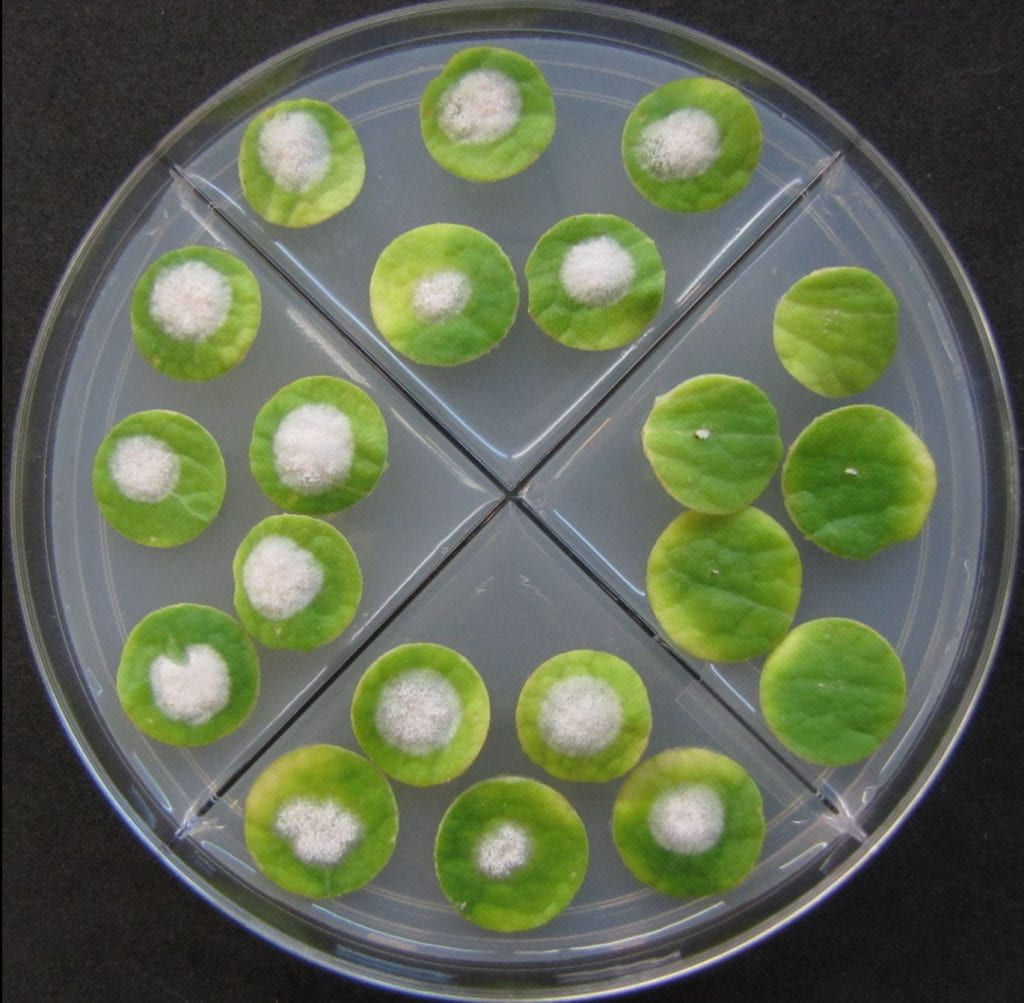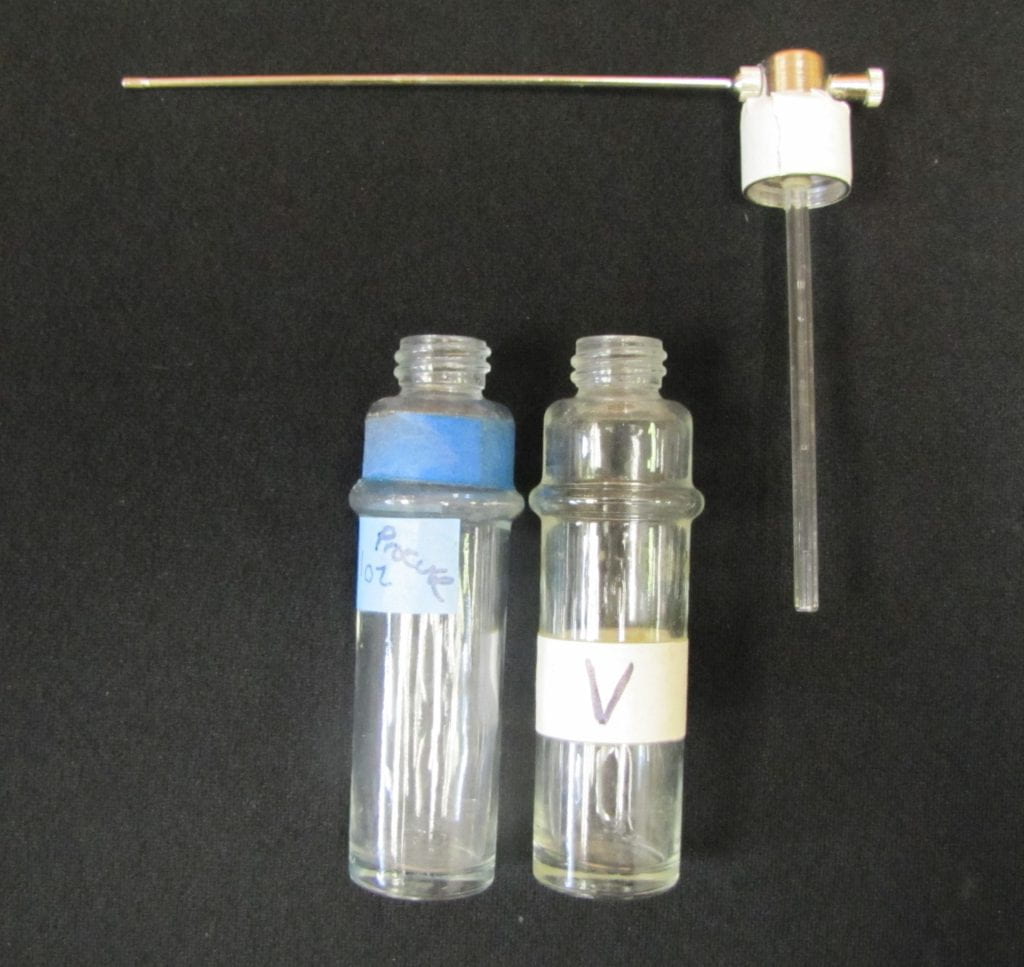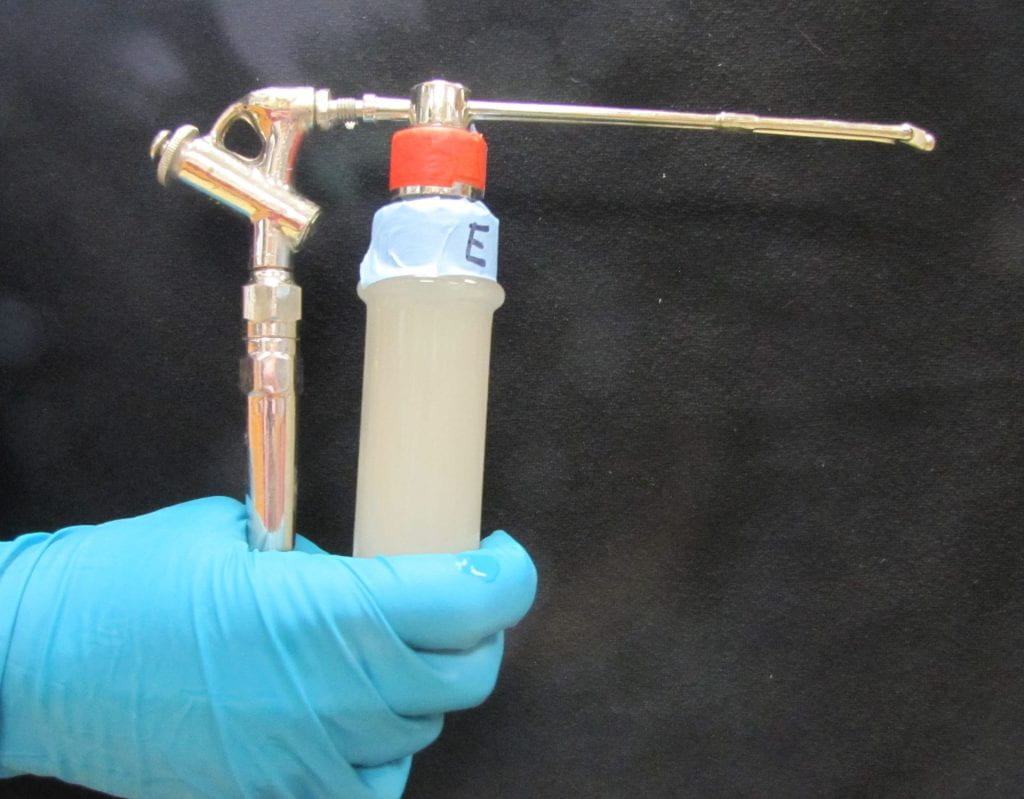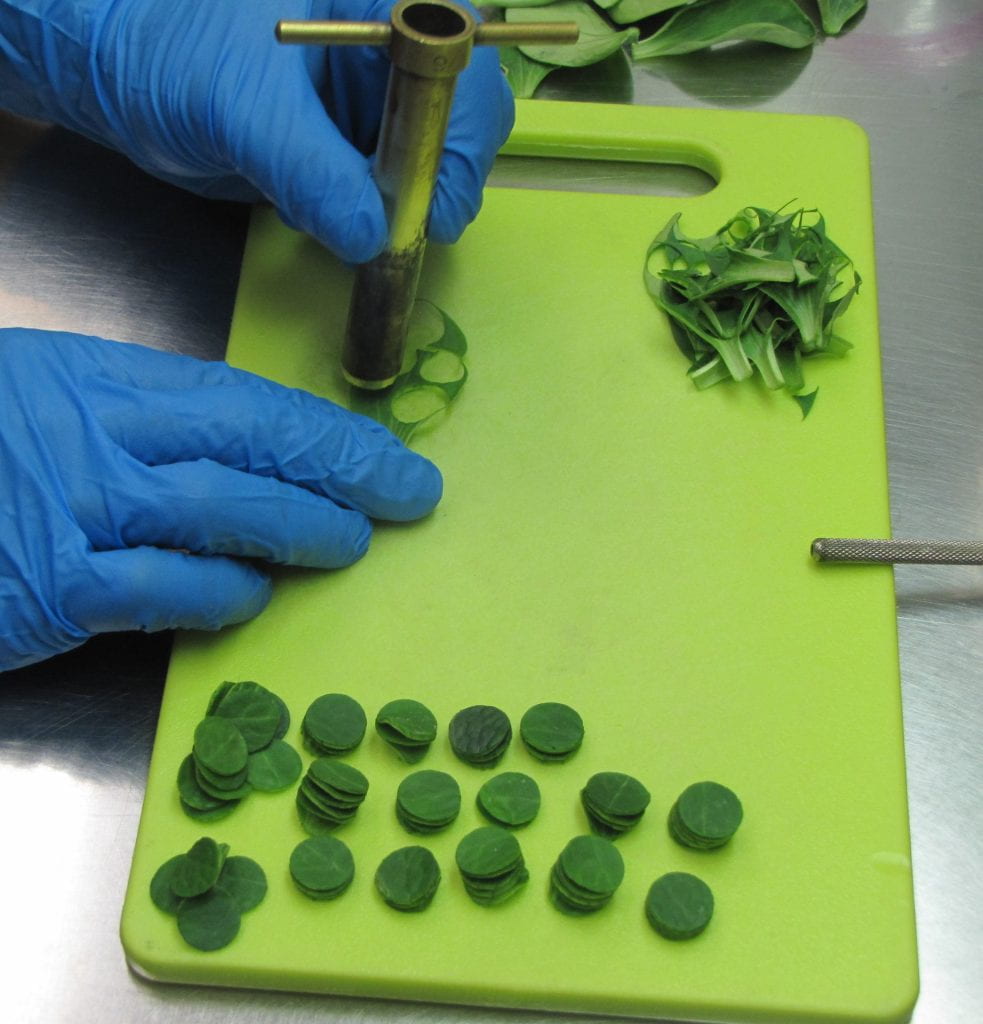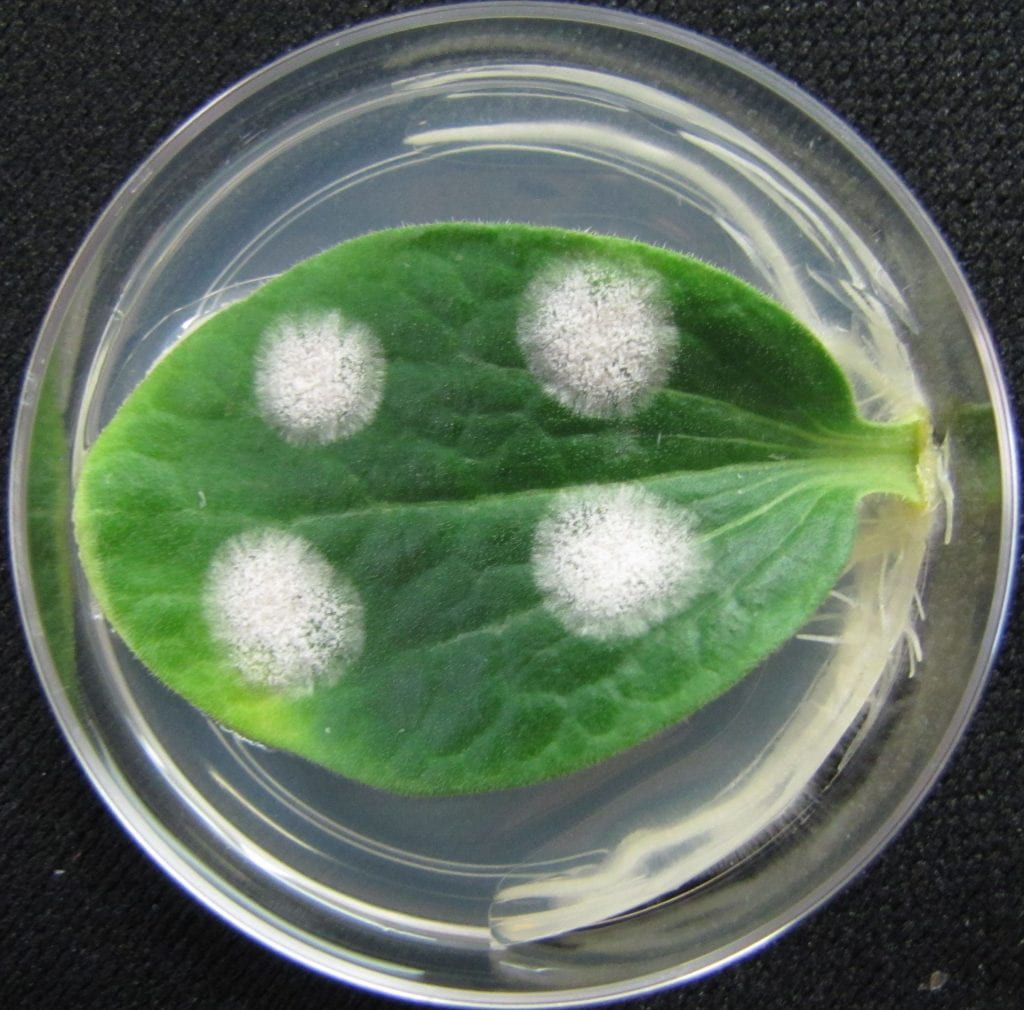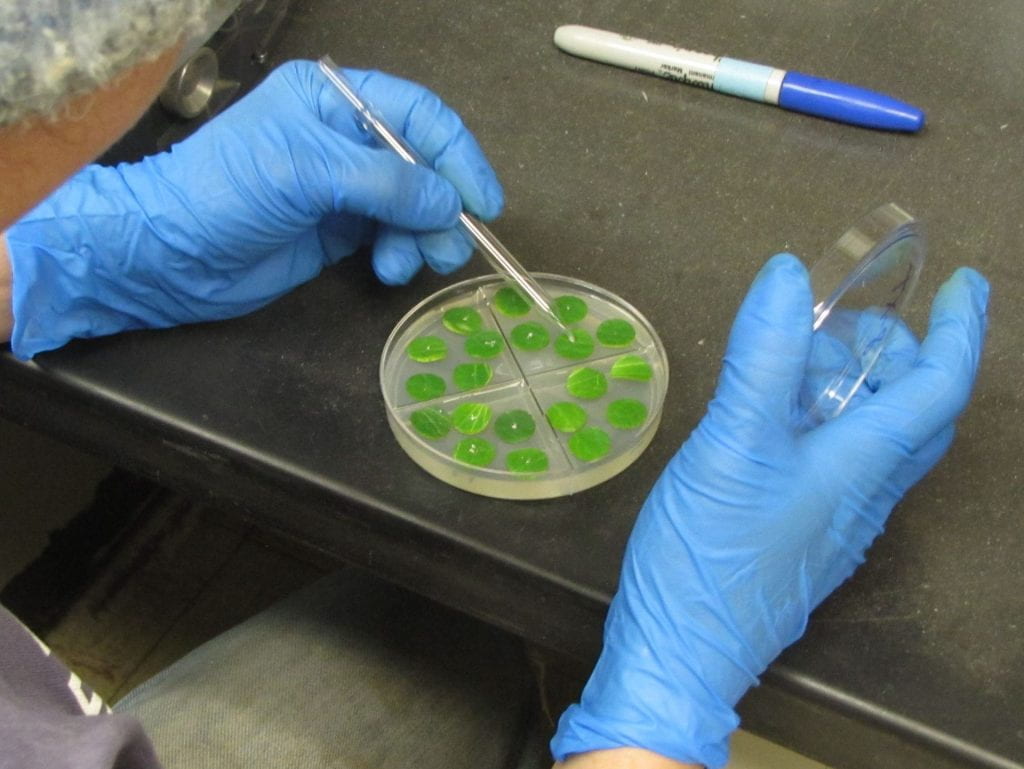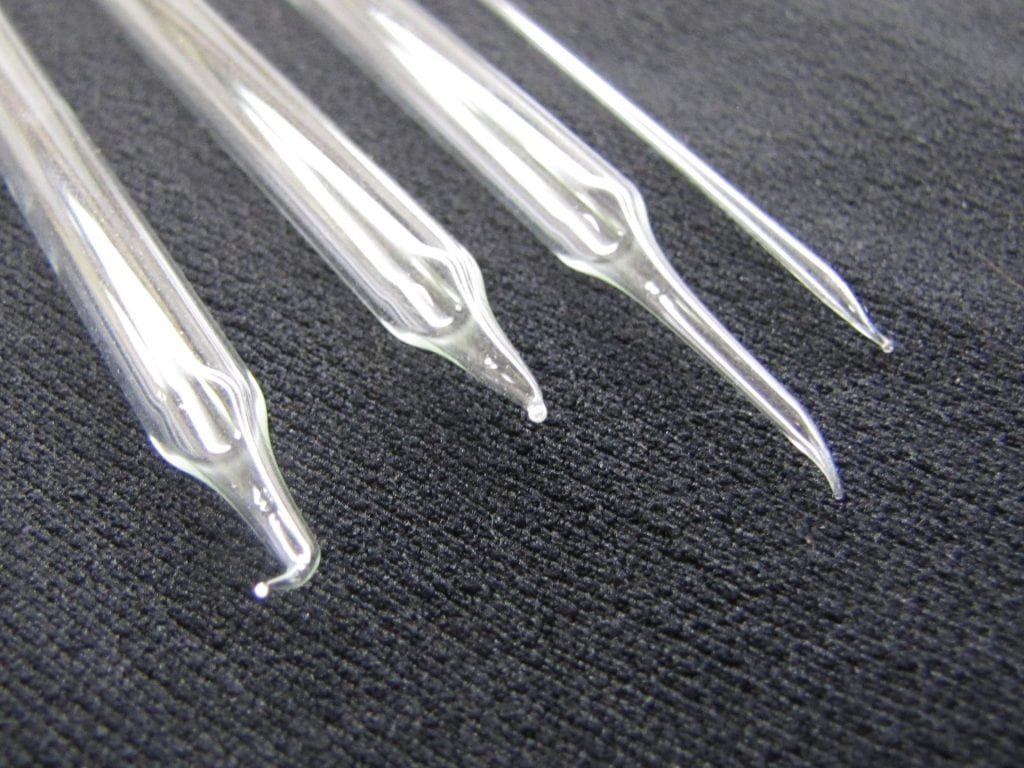Pathogen isolates (individuals) are obtained from single powdery mildew colonies (lesions) on field-grown leaves collected near the end of the growing season from commercial and research plantings on Long Island. Isolates have also been obtained from upstate New York. The isolates are maintained on cotyledons in petri dishes until tested in a bioassay. For the bioassay, seedlings at the cotyledon stage are treated with different fungicide doses, the next day 5 leaf disks are cut from the cotyledons and placed on water agar in a Petri dish, then the disks are inoculated by transferring spores from a culture to the center of each disk. About 10 and 14 days later severity is assessed on each disk. Typically isolates either do not grow or grow well often not showing obvious reduction in growth compared to non-treated disks. An isolate is considered to be insensitive (resistant) to a particular fungicide concentration if it was able to grow and produce spores on at least half of the disks.
Images of equipment and procedures
Detailed description of procedure.
Isolates Collected in 2023
At the end of the growing season, 12 isolates were obtained from plots in a fungicide evaluation that were treated with Vivando (FRAC 50) applied in alternation with a DMI (FRAC 3)(Proline twice, then Procure) for a total of 6 applications. Additional fungicides applied for treatments in other plots were Prolivo (50), Regev (3), Rhyme (3), and Theia (biopesticide). The table below has percent isolates determined to be resistant to Torino (FRAC U6), Quintec (13), and Endura (7). The dose of these 3 fungicides applied to leaves used in the bioassay is the dose in a spray tank when the fungicides are applied at 50 gpa, thus isolates able to tolerate and grow on the treated disks are fully resistant to the fungicide. Isolates were also tested for their sensitivity to Vivando (50). Isolates resistant to Vivando have not been detected yet.
Resistance to boscalid (FRAC 7)(500 ppm), active ingredient (AI) in Endura and Pristine, was detected in a high percentage of isolates although no fungicides in this FRAC group were applied in the research planting where the isolates were collected. This suggests resistance to this chemistry is common, at least on Long Island, and resistant isolates are competitive with sensitive isolates. Therefore, these and related fungicides are not recommended. Resistance to this chemistry has been detected for many years.
Resistance to Torino (U6)(50 ppm cyflufenamid, AI in Torino) was detected in a high percentage of isolates although Torino was not applied in the research planting where the isolates were collected. This suggests resistance to this chemistry is common, at least on Long Island, and resistant isolates are competitive with sensitive isolates. Therefore, Torino is not recommended. Resistance to this chemistry has been detected for many years.
Resistance to Quintec (13)(200 ppm quinoxyfen, AI in Quintec) was not detected. This fungicide was not applied in the research planting where the isolates were collected. Resistance to this chemistry has been detected in past years.
Vivando (50) at 50 ppm active ingredient (metrafenone) was tolerated by 83% of isolates, which was higher than previous years. 9 of the 10 tolerant isolates were tested at 150 ppm metrafenone; 3 tolerated this dose well with growth similar to that on untreated disks. Field dose is 600 ppm when Vivando is applied at 50 gpa, so these tolerant isolates do not appear to be a concern for control; however, these tolerant isolates were not tested at this rate and there is concern with continued use of this chemistry that the pathogen may become more insensitive and eventually resistant. The isolates tolerating 150 ppm metrafenone were resistant to boscalid and Torino.
| Location | Powdery mildew fungicides used | Percent resistant isolates | ||||
| # Isolates | Torino | Quintec | Endura | R to all | ||
| LIHREC Fungicide Evaluation | Vivando 3X alt Proline 2X, Procure 1X | 12 | 42 | 0 | 83 | 0 |
Isolates Collected in 2022
At the end of the growing season 58 isolates were obtained from 7 commercial crops in upstate New York (5 in western NY and 2 in eastern NY) and 59 isolates were obtained from 4 research plantings at LIHREC. Isolates were obtained from 3 different fungicide treatments in planting 2 which was a fungicide evaluation. The table below has percent isolates determined to be resistant to Torino (FRAC U6), Quintec (13), and Endura (7) at the 8 locations. The dose of these 3 fungicides applied to leaves used in the bioassay is the dose in a spray tank when the fungicides are applied at 50 gpa, thus isolates able to tolerate and grow on the treated disks are fully resistant to the fungicide. Isolates were also tested for their sensitivity to Vivando (50), Rally (3), and fluopyram (7), the active ingredient in Luna fungicides. Luna Privilege was used because it is the only formulation that does not have a second active ingredient for powdery mildew; it is not labeled for this use. Isolates resistant to these fungicides have not been detected.
Resistance to boscalid (FRAC 7)(500 ppm), active ingredient (AI) in Endura and Pristine, was detected in all plantings although there were no applications of these or another FRAC 7 (SDHI) fungicide except in WNY commercial crop 5 which was treated once with Miravis Prime. It contains pydiflumetofen. The highest frequency (100%) of isolates resistant to boscalid were found in this crop (see Table below) suggesting the application of Miravis Prime selected for resistance to FRAC 7 fungicides. Resistance to Endura was detected in an average of 38% of isolates from the commercial crops and 51% of isolates from the LIHREC research plantings. Endura and Pristine are not recommended because they will provide little to no control. Some FRAC 7 fungicides bind slightly differently (notably boscalid, pydiflumetofen, and fluopyram which is the AI in Luna fungicides) and there are different mutations responsible for resistance and reduced sensitivity to these fungicides; these facts account for why there is not full cross resistance among all FRAC 7 fungicides. Resistance to boscalid is suspected to be the result of a single mutation while reduced sensitivity and resistance to the others is likely due to multiple mutations.
Resistance to Torino (U6)(50 ppm cyflufenamid, AI in Torino) was not detected in any of the commercial plantings (see Table below). It was detected in 2 research plantings. This chemistry was not applied in any of the sampled plantings. 5 of the 11 Torino-resistant isolates tolerated 50 ppm Vivando, which was applied in the research plantings and could account for their selection. 3 of these plus 1 other Torino-resistant isolate were also resistant to Quintec; however, this fungicide was not applied. Lack of an explanation for occurrence of most of the Torino-resistant isolates (6 of 11) provides additional evidence that Torino-resistant isolates are fit and can be present in a pathogen population at a detectable level despite lack of fungicide use to select them.
Resistance to Quintec (13)(200 ppm quinoxyfen, AI in Quintec) was detected in 2 commercial plantings and the same research plantings where resistance to Torino was detected (see Table below). Resistance to Quintec was detected in 1 of the 3 commercial crops where this fungicide was applied. It was only applied once to each crop which appears to not be enough to cause detectable selection if resistant isolates were present. Isolates resistant to Quintec were found more commonly in 2021 in particular in crops where Quintec was applied twice (see 2021 results below). Surprisingly, Quintec-resistant isolates were detected in the research plantings where Quintec was not applied but not in the 2 plantings where it was applied once or twice. The rationale for the fungicide programs selected for LIHREC research plantings 3 and 4 was to evaluate resistance management programs. Results suggest these programs were effective. Detecting resistance where Quintec was not applied provides additional evidence that Quintec-resistant isolates are fit and can be present in a pathogen population at a detectable level despite lack of fungicide use to select them.
Vivando (50) at 50 ppm active ingredient (metrafenone) was tolerated by 28% of isolates, which was similar to 2021 but more than previous years (see Table below). Field dose is 600 ppm when Vivando is applied at 50 gpa, so these tolerant isolates are not a concern for control, but there is concern the pathogen may become more insensitive and eventually resistant. Isolates tolerating Vivando at 50 ppm were found commonly in the 3 research plantings treated thrice with Vivando (50-67% of isolates), but they were also common in plots treated just once (30% and 60% of isolates) and an isolate (=10% of the isolates tested) was found in plots treated just with a biopesticide (Serifel). Isolates tolerating Vivando at 50 ppm active ingredient (metrafenone) were found in 2 of 3 crops where this fungicide was applied 1 or 2 times, but also in 2 of 3 crops where this fungicide was not applied. 150 ppm metrafenone was tolerated by none of the 17 isolates tested at this dose; they were able to grow on disks treated with 50 ppm.
The Luna fungicide (7) active ingredient that is in all formulations, fluopyram, at 50 ppm was tolerated by 76% of isolates from upstate NY (commercial crops), 66% of isolates from Long Island (research plots), and 71% of all isolates (see Table below). 50% of isolates were resistant to Endura and also tolerated 50 ppm fluopyram. These FRAC 7 fungicides bind differently in the pathogen thus they do not exhibit full cross resistance. 150 ppm fluopyram was tolerated by 3 of the 24 isolates tested at this dose; these isolates were able to grow on disks treated with 50 ppm. None of these isolates tolerated 300 ppm. Isolates tolerating 150 ppm likely would not be controlled by Luna Experience applied at 6 fl oz/A (lowest label rate) and 50 gpa because the field dose at this rate is 165 ppm fluopyram while it is 467 ppm at 17 fl oz/A. The 3 isolates were from a commercial crop in western NY that was treated with Prolivo, another FRAC 50 fungicide.
The DMI (FRAC 3) fungicide Rally at 40 ppm active ingredient (myclobutanil) was tolerated by only 14% of isolates (33% in 2021) with most exhibiting less than 50% growth compared to the isolate’s growth on untreated disks. These isolates were collected from plants that had been sprayed with a DMI fungicide one to four times. There was no evident relationship between DMI fungicide use and presence of tolerant isolates; in fact, the greatest number of isolates tolerating Rally at 40 ppm (33%) came from a commercial field where no DMI fungicide was applied. None of the isolates tested (25) were able to grow on leaf disks treated with 80 ppm. Field dose is 150 – 300 ppm myclobutanil when Rally is applied at 2.5 – 5 oz/A at 50 gpa. Thus, while isolates are being detected with reduced sensitivity to DMI fungicides, they are expected to be controlled by these fungicides. Some isolates were tested and found able to tolerate the DMI fungicides Procure and Proline at 40 ppm.
Multi-fungicide resistant isolates with resistance to Endura, Quintec, and Torino were rare in 2022 with only 1 detected (1%), in contrast with previous years, in particular 2018 and 2019 when 35% and 38% of isolates were resistant to all of these fungicides. This likely is due to decreased use of Quintec combined with lack of use of Endura and Torino, and limited use of other FRAC 7 fungicides.
Occurrence of fungicide resistance in cucurbit powdery mildew isolates collected from commercial and research plantings in 2022.
| Percent resistant isolates | ||||||
| Location | Powdery mildew fungicides used | # Isolates | Torino | Quintec | Endura | R to all |
| WNY Commercial crop 1 | Rhyme, Inspire Super. Mostly chlorothalonil +/or copper | 9 | 0 | 0 | 11 | |
| WNY Commercial crop 2 | Rhyme, Vivando, Rhyme+Vivando, Rhyme+Revus Top | 9 | 0 | 0 | 44 | |
| WNY Commercial crop 3 | Inspire Super. Mostly chlorothalonil alt. copper | 4 | 0 | 0 | 50 | |
| WNY Commercial crop 4 | not provided | 9 | 0 | 11 | 33 | |
| WNY Commercial crop 5 | Prolivo, Quintec, Miravis Prime, Inspire Super* | 9 | 0 | 11 | 100 | |
| ENY Commercial crop 1 | Quintec, Vivando. * Mostly chlorothalonil + copper | 9 | 0 | 0 | 56 | |
| ENY Commercial crop 2 | Vivando, Rhyme, Quintec * | 9 | 0 | 0 | 78 | |
| LI Research field 1 – LIHREC | Serifel | 10 | 10 | 20 | 40 | |
| LI Research field 2a – LIHREC | Proline, Vivando, Proline | 10 | 50 | 40 | 20 | 1 isolate |
| LI Research field 2b – LIHREC | Serifel, Proline, Vivando, Proline, Serifel | 10 | 10 | 20 | 40 | |
| LI Research field 2c – LIHREC | Proline, Vivando, Proline, Vivando, Procure, Vivando | 10 | 40 | 10 | 50 | |
| LI Research field 3 – LIHREC | DMI (Proline or Procure) 3X, Vivando 3X, Quintec | 9 | 0 | 0 | 67 | |
| LI Research field 4 – LIHREC | DMI 4X, Vivando 3X, Quintec 2X + biopesticides | 10 | 0 | 0 | 90 | |
| Eastern + Western NY Commercial crops – Total | 58 | 0 | 3 | 53 | 0 | |
| Long Island – Total | 59 | 19 | 15 | 51 | 1.7 | |
| All isolates | 117 | 9 | 9 | 52 | 0.9 | |
* all applications made with contact fungicides: copper and/or chlorothalonil, or sulfur.
Following are bioassay plates of some isolates collected in 2022. See also images from previous years illustrating growth on disks treated with other fungicides.
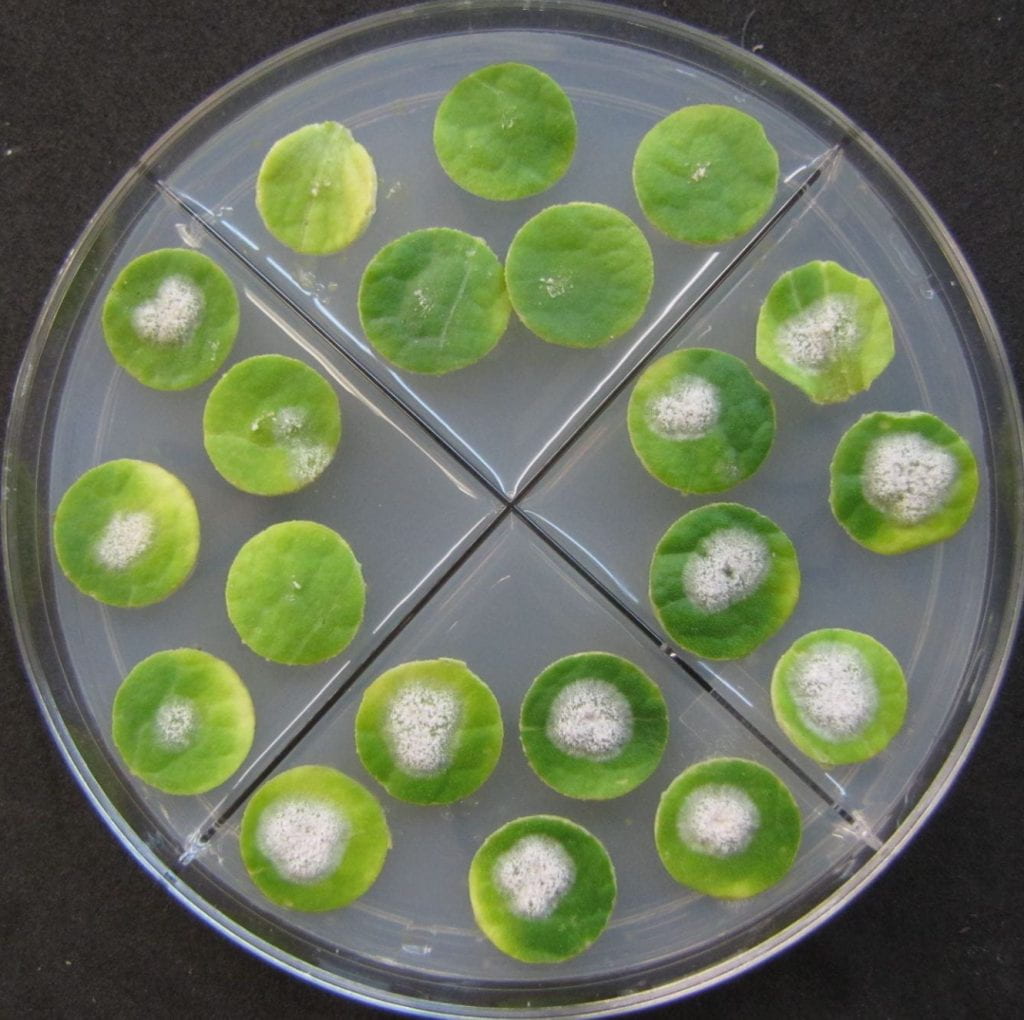
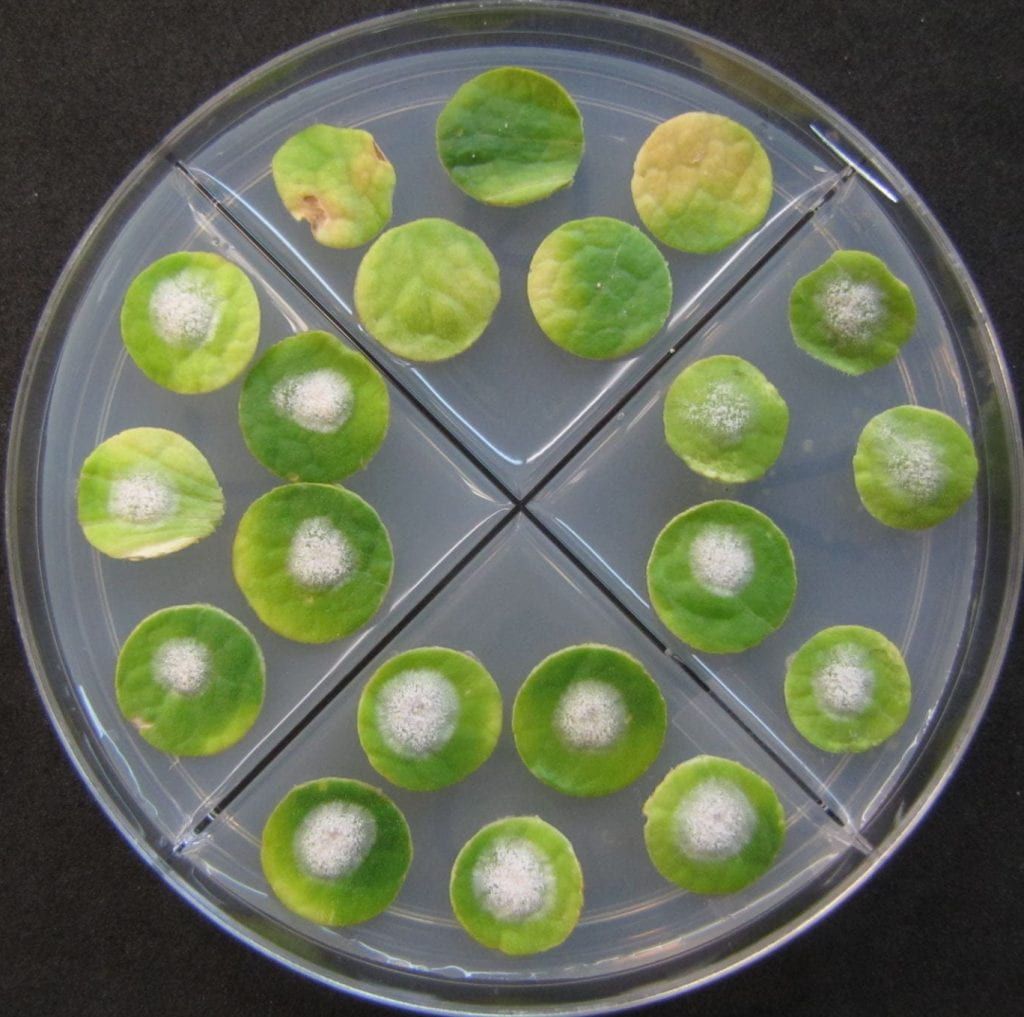

Isolates Collected in 2021
Isolates were collected at the end of the growing season from a research planting at LIHREC and commercial crops on Long Island and in upstate New York. There were 32 isolates from the research planting and 90 isolates from commercial plantings: 3 farms in western NY, 9 in eastern NY, and 1 on Long Island. The table has percent of the isolates determined to be resistant to Torino (FRAC U6), Quintec (13), and Endura (7) at the 14 locations. The dose of these 3 fungicides applied to leaves used in the bioassay is the dose in a spray tank when the fungicides are applied at 50 gpa, thus isolates able to tolerate and grow on the treated disks are fully resistant to the fungicide.
Resistance to boscalid (FRAC 7)(500 ppm), active ingredient (AI) in Endura and Pristine, was detected in all plantings although there were no applications of this fungicide nor Pristine, which has the same active ingredient (boscalid), nor another cross resistant fungicide in this FRAC group (e.g. Merivon) to select for this resistance. These fungicides are not recommended because they will provide little to no control. 61% of isolates were resistant to Endura.
Resistance to Quintec (13)(200 ppm quinoxyfen, AI in Quintec) and Resistance to Torino (U6)(50 ppm cyflufenamid, AI in Torino) were mostly detected in plantings where one of these fungicides was applied (see Table below). This documents that using them during a growing season selects resistant isolates to a detectable degree that is expected to impact their efficacy. These fungicides were not used and resistance was not detected in four locations: WNY commercial crop 1 and 3, ENY commercial crop 1, and the research field at LIHREC. Resistance to Quintec was common (67, 71, and 100% of isolates) in the three locations where this fungicide was applied twice, despite the fact its use for all three plantings was in a recommended resistant management program consisting of an alternation among targeted fungicides all tank mixed with contact fungicides: ENY commercial crop 3, 5, and 6. Notably, ENY commercial crop 3 where all isolates were resistant to Quintec is only a few miles from ENY commercial crops 1 and 2 where resistance was not detected. However, resistance to Quintec was not detected in ENY commercial crop 4 where it was applied once. Additionally, resistance was detected in four locations where these fungicides were not applied: WNY commercial crop 2, ENY commercial crop 7 and 8, and the Long Island commercial crop. Selection for resistance to Quintec perhaps occurred in other nearby crops treated with this fungicide. Detection of resistance to Quintec in crops where the fungicide was not used indicates this resistance is somewhat common, albeit not as common as resistance to Endura, and that resistant isolates are able to compete with sensitive isolates. Resistance to Torino was detected in 1 of the 2 locations where it was applied (ENY commercial crop 9) and 5 locations where this fungicide was not used. This finding partly reflects the fact that 15 of the 22 isolates (68%) that were resistant to Torino were also resistant to Quintec, thus applying Quintec would have selected these isolates with resistance to both fungicides.
In the research field at LIHREC in 2021, while many isolates (61%) were found to be resistant to Endura, resistance to Torino and Quintec was not detected as it had been in previous years.
Resistance to QoI fungicides (FRAC 11) was detected in all 23 isolates tested. QoI resistance has been common for many years indicating this trait is remaining in the pathogen population although these fungicides have not been recommended for many years. QoI resistance was first detected in NY in 2002.
Multi-fungicide resistant isolates were detected in 2021, but not at as high a percentage as in 2018 – 2020. Resistance to Endura, Quintec, and Torino was detected in 35%, 38%, and 19% of the isolates those years, respectively, versus 11% of the 122 isolates from commercial and research plantings collected in 2021. Likely all isolates were also resistant to QoI fungicides.
Isolates were also tested for their sensitivity to Vivando, FRAC 7 ingredient in Luna fungicides, and the DMI (FRAC 3) fungicides Rally, Procure, and Proline. The main goal was to determine if there were pathogen isolates less sensitive to these chemistries than isolates tested in the past.
Vivando (50) at 50 ppm active ingredient (metrafenone) was tolerated by more isolates than in the past (31%). Field dose is 600 ppm when Vivando is applied at 50 gpa, so these tolerant isolates are not a concern for control, but there is concern the pathogen may become more insensitive and eventually resistant. Interestingly, isolates tolerating Vivando at 50 ppm were not found more commonly in plantings treated with Vivando than those that were not (23% versus 43% of isolates). 20 isolates that tolerated 50 ppm were sensitive to 150 ppm.
The Luna fungicide (7) active ingredient that is in all formulations, fluopyram, at 50 ppm was tolerated by 86% of the isolates that were resistant to Endura. Cross resistance among these FRAC 7 fungicides was not expected because these fungicides bind differently in the pathogen. 60% of isolates from commercial crops and 55% of all isolates tolerated 50 ppm fluopyram. 150 ppm fluopyram was tolerated by 2 of the 32 isolates tested at this dose, which were all isolates able to tolerate 50 ppm. Isolates tolerating 150 ppm likely would not be controlled by Luna Experience applied at 6 fl oz/A (lowest label rate) and 50 gpa because the field dose at this rate is 165 ppm fluopyram while it is 467 ppm at 17 fl oz/A.
The DMI (FRAC 3) fungicide Rally at 40 ppm was tolerated by 33% of isolates with most exhibiting less than 50% growth compared to the isolate’s growth on untreated disks; 49% of isolates from plantings treated with a DMI fungicide. 2 isolates tolerated Rally at 100 ppm. Interestingly they were from a planting where DMR fungicides were not applied. Field dose is 150 – 300 ppm when Rally is applied at 2.5 – 5 oz/A at 50 gpa. 17 of 28 isolates tolerating 40 ppm Rally were tested and found able to grow on leaf disks treated with 80 ppm Rally, Procure, and/or Proline, but only 8 exhibited growth not reduced by at least 50% compared to their growth on untreated disks. Thus while isolates are being detected with reduced sensitivity to DMI fungicides, they are expected to be controlled by these fungicides.
Occurrence of fungicide resistance in cucurbit powdery mildew isolates collected from commercial and research plantings in 2021.
| Location | Powdery mildew fungicides used | # Isolates | Percent resistant isolates | |||
| Torino | Quintec | Endura | R to all | |||
| WNY Commercial crop 1 | Just contact fungicides: Stylet-oil and copper | 1 | 0 | 0 | 100 | 0 |
| WNY Commercial crop 2 | Just contact fungicides: Bravo and copper | 7 | 0 | 29 | 86 | 0 |
| WNY Commercial crop 3 | Inspire Super twice, Rally + Bravo | 7 | 0 | 0 | 86 | 0 |
| ENY Commercial crop 1 | Just contact fungicides: chlorothalonil + copper | 7 | 0 | 0 | 14 | 0 |
| ENY Commercial crop 2 | Torino, Vivando – probably twice each* | 8 | 0 | 0 | 13 | 0 |
| ENY Commercial crop 3 | Quintec,Vivando, Vivando* | 9 | 0 | 0 | 56 | 0 |
| ENY Commercial crop 4 | Quintec, Vivando, Quintec + Vivando* | 6 | 67 | 100 | 100 | 67 |
| ENY Commercial crop 5 | Vivando, Quintec, Rhyme, Vivando, Quintec* | 3 | 0 | 67 | 67 | 0 |
| ENY Commercial crop 6 | Quintec, Rhyme, Prolivo, Gatten, Prolivo, Quintec, Prolivo, Gatten* | 7 | 71 | 71 | 86 | 57 |
| ENY Commercial crop 7 | Gatten, Vivando, Gatten | 9 | 11 | 11 | 44 | 11 |
| ENY Commercial crop 8 | Quadris Top, Vivando + Quadris Top, Procure* | 6 | 33 | 17 | 33 | 17 |
| ENY Commercial crop 9 | contact fungicides, Torino mid-Sept | 8 | 75 | 50 | 88 | 50 |
| LI Commercial crop | Proline, Vivando, Procure, Proline* | 12 | 33 | 0 | 67 | 0 |
| LI Research field – LIHREC | Most plots: Proline alt Vivando, 3 or 6 apps | 31 | 0 | 0 | 64 | 0 |
| Eastern NY Commercial crops – Total | 63 | 29 | 30 | 54 | 22 | |
| Western NY Commercial crops – Total | 15 | 0 | 13 | 87 | 0 | |
| Long Island Commercial crops – Total | 12 | 33 | 0 | 67 | 0 | |
| Commercial crops – Total | 90 | 24 | 23 | 61 | 16 | |
| All isolates | 122 | 18 | 17 | 61 | 11 | |
* all applications made with contact fungicides: copper and/or chlorothalonil. Records not obtained for ENY crop 2.
Gatten not permitted used on Long Island
Following are bioassay plates of some isolates collected in 2021.
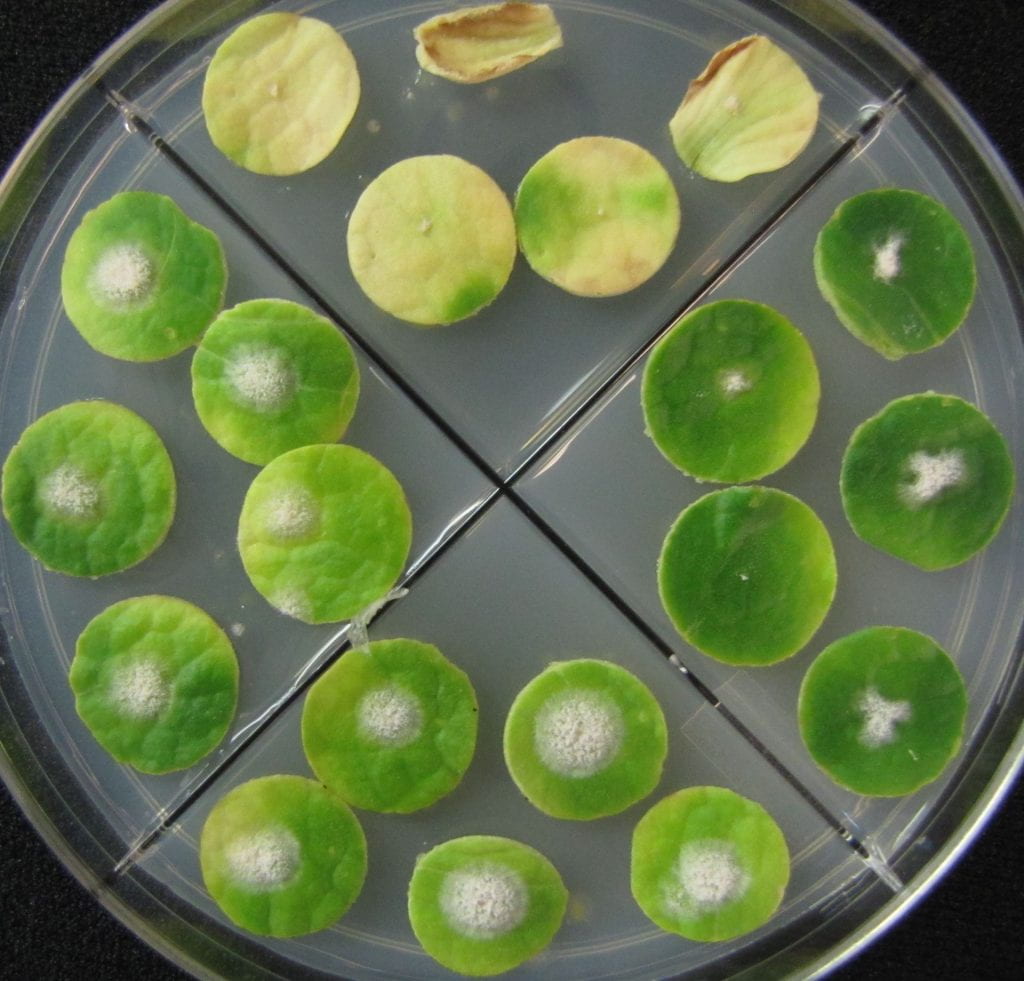
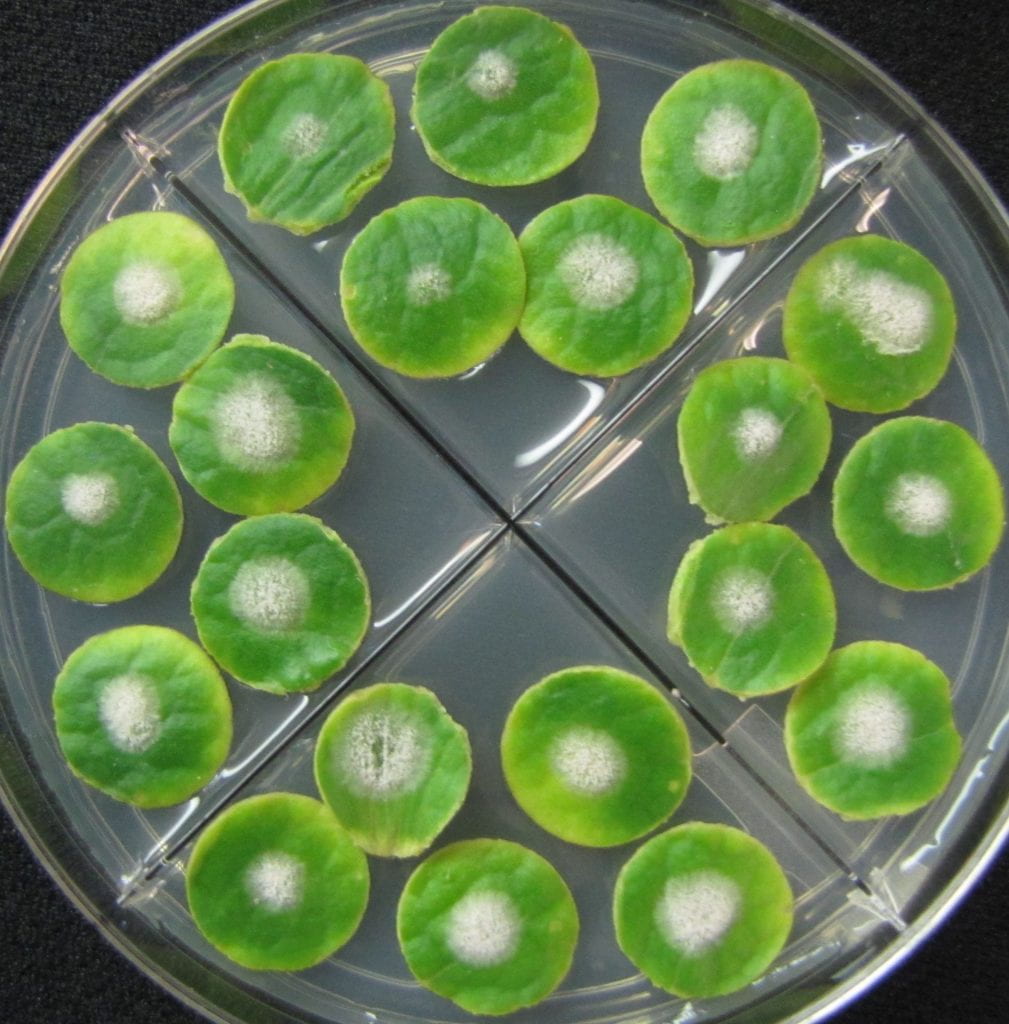
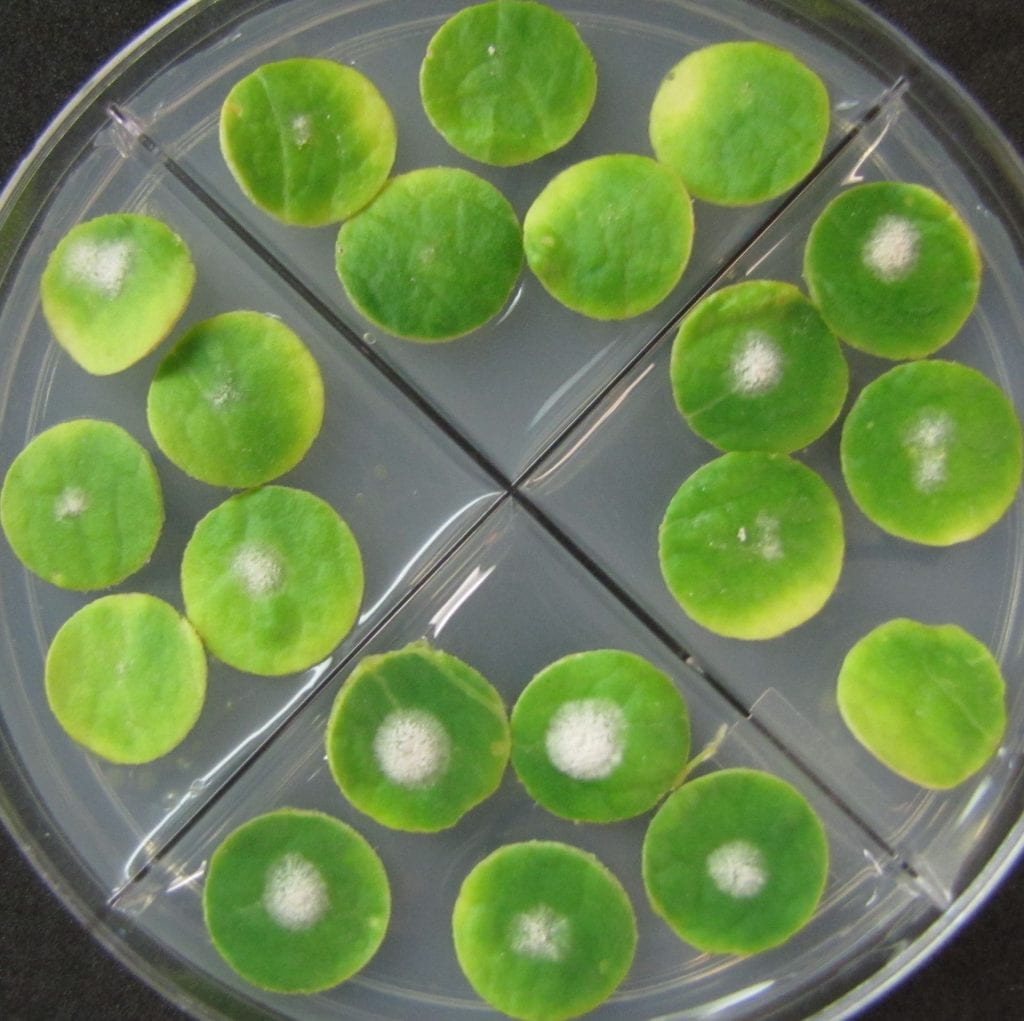
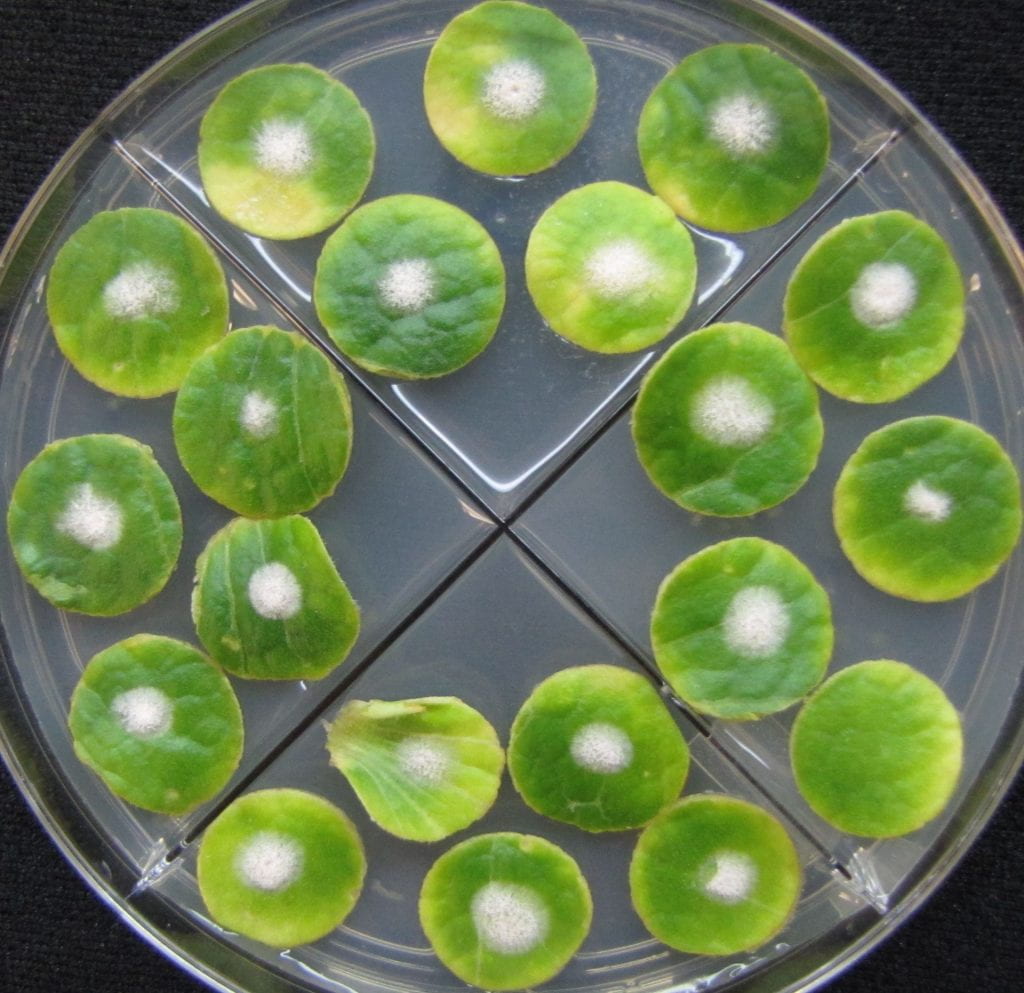
Isolates Collected in 2020
A total of 57 isolates were collected on 15 September 2020 from 2 commercial pumpkin fields in eastern NY north of Albany, on 25 September from 2 commercial pumpkin fields on Long Island, and on 28 September from 2 research fields of pumpkin and acorn squash on LI.
As in 2018 and 2019, there were isolates resistant to 3 chemistries: Endura (FRAC 7), Quintec (13), and Torino (U6). Notably, all isolates with resistance to Quintec were resistant to all 3 of these chemically different fungicides. They were from the two plantings where this fungicide was applied (10 isolates from a commercial planting in eastern NY and 1 from a research planting on LI) suggesting selection for resistance to Quintec from its use in these plantings and also that only multi-fungicide resistant isolates were present. There were isolates resistant only to Torino (23%) of these 3 chemistries and isolates resistant only to Endura (21%), but no isolates resistant to both Torino and Endura or resistant only to Quintec. All but 1 of the 13 isolates determined to be resistant only to Torino were obtained from LI, while all but 1 of the 12 isolates determined to be resistant only to Endura were obtained from eastern NY, suggesting regional differences in the pathogen populations, perhaps reflecting local fungicide use although Torino was not applied in any of the LI plantings samples and no FRAC 7 fungicides were applied in the eastern NY commercial plantings. No resistance to Endura, Quintec, or Torino was found in the commercial field on LI where Vivando (50) and Proline (3) were applied to manage powdery mildew.
Resistance to QoI fungicides (FRAC 11) was detected in all isolates, similar to previous years. This trait is remaining in the pathogen population although these fungicides have not been recommended for many years. QoI resistance was first detected in NY in 2002.
38.6% of the 57 isolates were able to grow on leaf disks treated with 50 ppm Luna Privilege. This fungicide contains fluopyram, an SDHI (FRAC 7) fungicide that binds differently from boscalid, the active ingredient in Endura and Pristine, thus these fungicides do not exhibit full cross resistance. Luna Privilege is used in the bioassays because it contains only fluopyram whereas the fungicides with fluopyram that are labeled for cucurbit powdery mildew, Luna Experience and Luna Sensation, contain another active ingredient (FRAC 3 and 11, respectively). Isolates able to tolerate 50 ppm Luna Privilege are not considered resistant because this dose is well below the field rate and these isolates have not been associated with control failure in the field. Of the 22 isolates tolerating 50 ppm Luna Privilege, 16 were resistant to Endura and 6 were sensitive to Endura. 7 isolates resistant to Endura were sensitive to 50 ppm Luna Privilege.
All isolates were sensitive to Vivando (50 ppm).
Occurrence of fungicide resistance in cucurbit powdery mildew isolates collected from commercial and research plantings in 2020.
| Location | Powdery mildew fungicides used | # Isolates | Percent resistant isolates | |||
| Endura | Torino | Quintec | R to all | |||
| Commercial pumpkin LI | Proline, Vivando, Proline + Vivando | 7 | 0 | 0 | 0 | 0 |
| Research field squash LI | Procure alt Vivando | 11 | 0 | 36 | 0 | 0 |
| Commercial pumpkin LI | Protectants only | 8 | 13 | 63 | 0 | 0 |
| Commercial pumpkin NY | Quintec | 12 | 83 | 25 | 25 | 25 |
| Commercial pumpkin NY | Quintec, Vivando, Quintec, Torino | 12 | 92 | 67 | 58 | 58 |
| Research field pumpkin LI | Fungicide evaluation (FRAC 3, 7, 13, 50)* | 7 | 14 | 57 | 14 | 14 |
| TOTAL | 57 | 40.4 | 42.1 | 19.3 | 19.3 | |
* Isolates collected from untreated plots and plots treated with Luna Privilege, Procure, Quintec, and/or Vivando
Following are bioassay plates of an isolate with multi-fungicide resistance (first) and a sensitive isolate. Both isolates were collected in 2020.
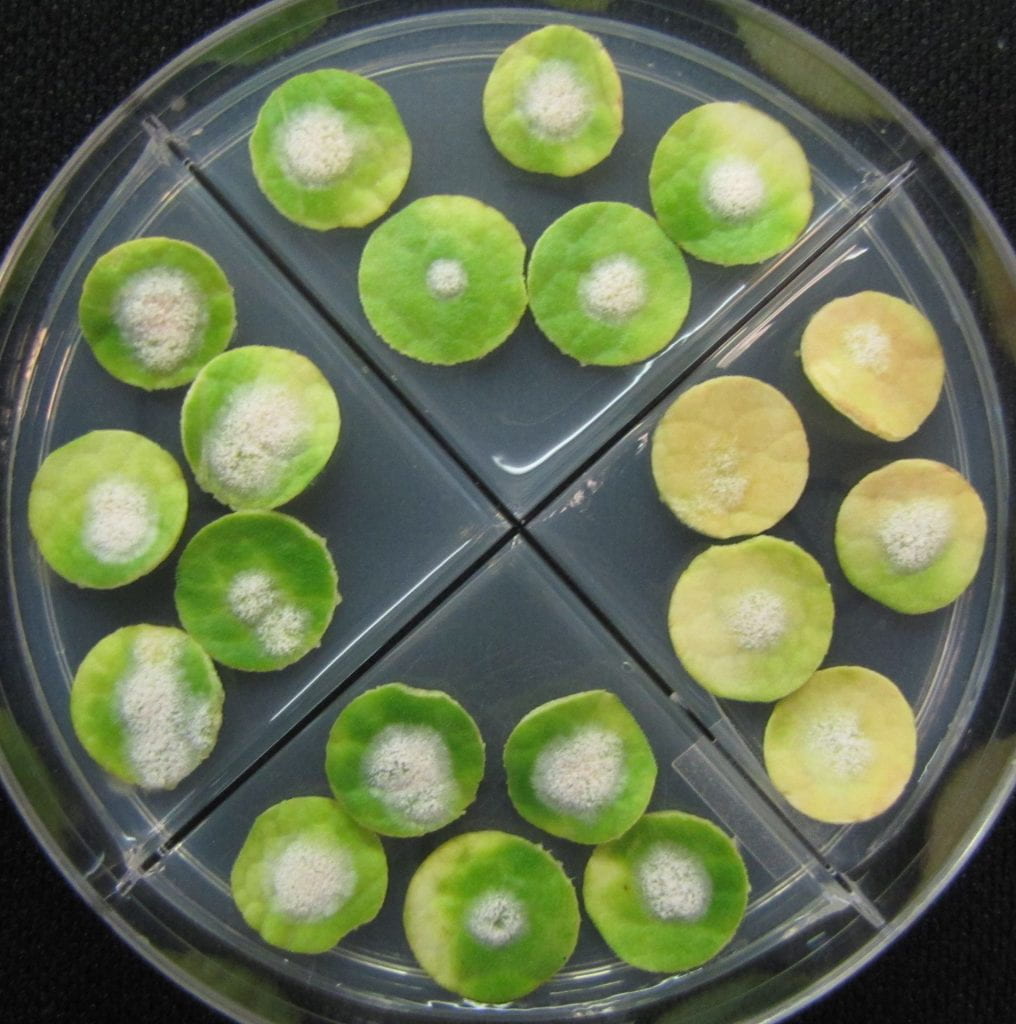

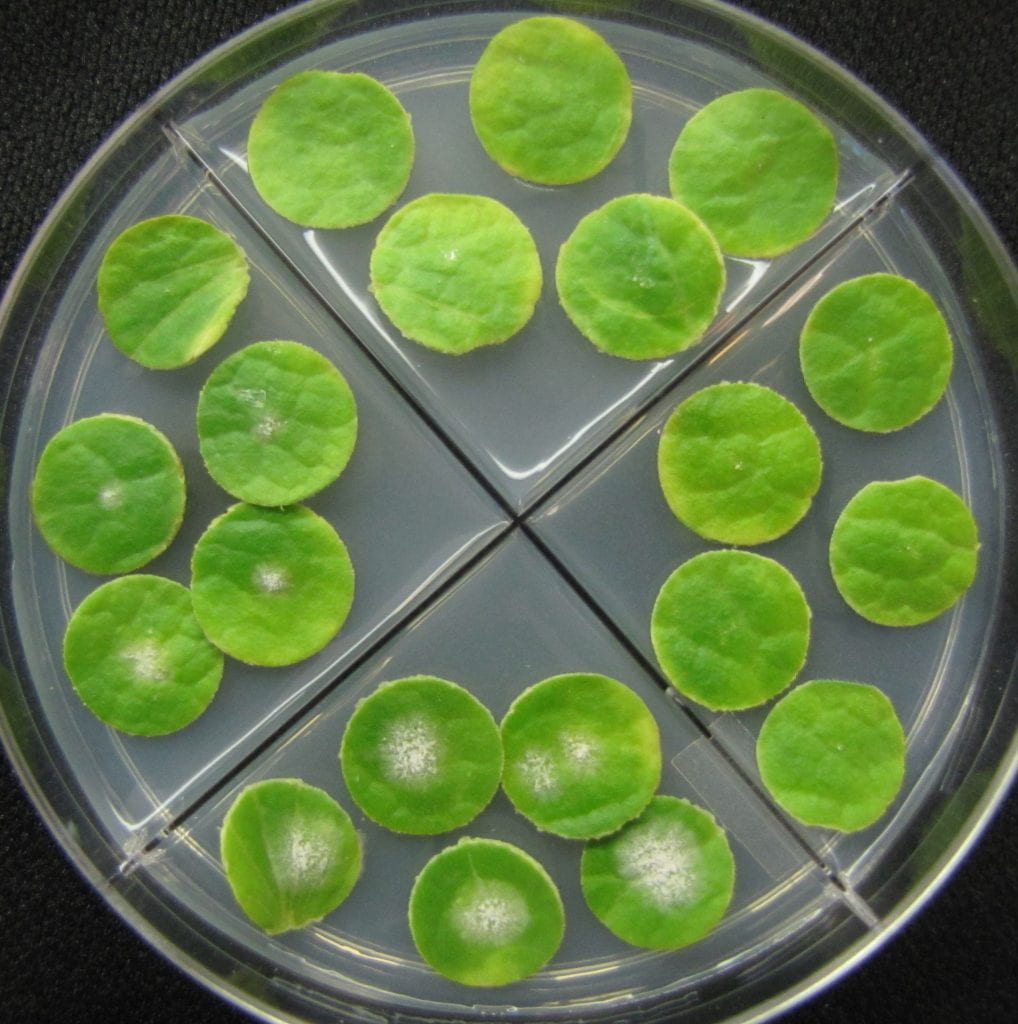
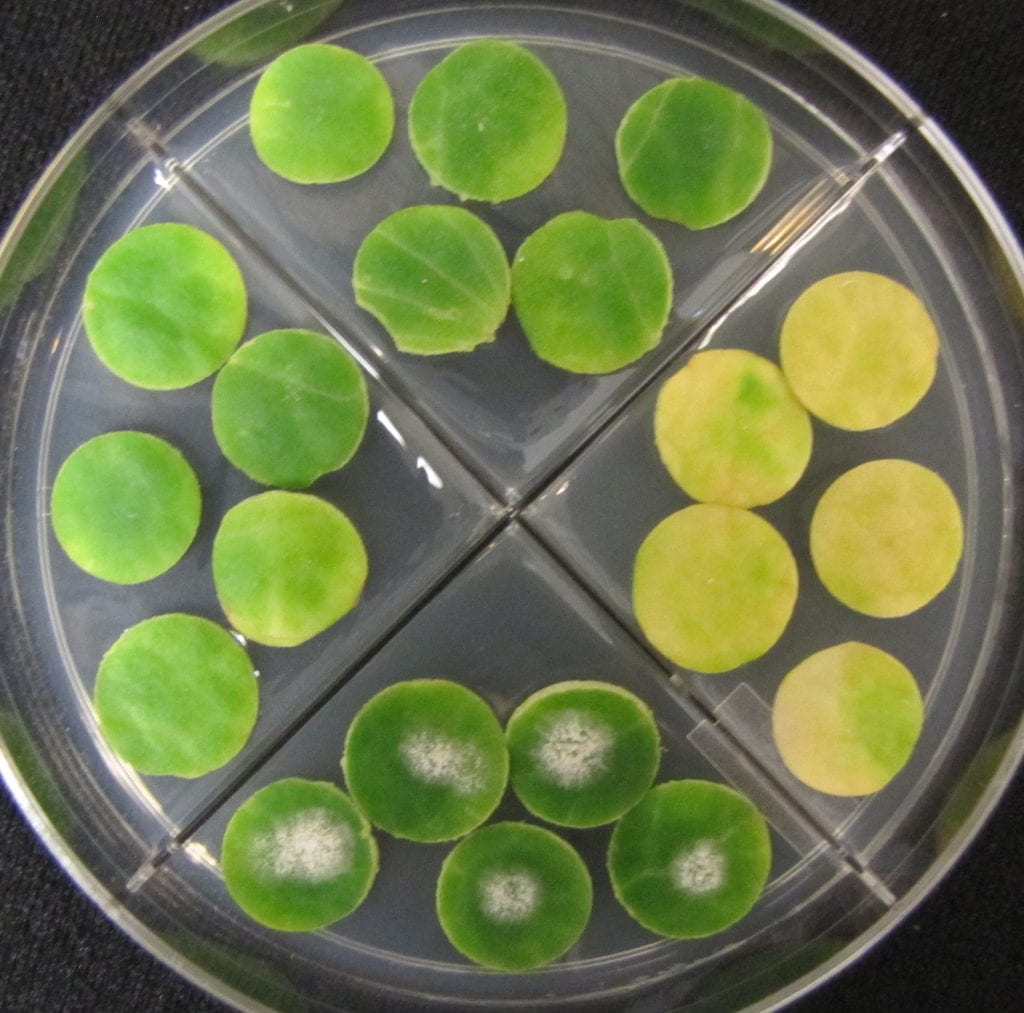
Isolates Collected in 2019
47 isolates were collected in mid- September 2019 from 2 research fields and 2 commercial crops.
Resistance to QoI fungicides (FRAC 11) and resistance to MBC fungicides (1) was detected in all but 1 isolate tested. About half of the isolates, including ones from all 4 locations sampled, were tested for resistance to these older chemistries, which have not been recommended and so presumably not used for many years. This documents that resistance to FRAC 1 and 11 chemistry continues to be stable in the pathogen population; isolates with this resistance are not less fit than sensitive isolates.
Resistance to boscalid (7)(500 ppm), active ingredient (AI) in Endura and Pristine, was detected in 43% of isolates, which was similar to previous years. This fungicide was not used in any of the sampled locations thus resistance occurrence did not reflect selection from use of either fungicide, but another FRAC 7 fungicide (Luna Sensation) was used in one of the research plots where isolates were collected. Boscalid resistance was very common (detected in all isolates tested) from plants treated with just Luna Sensation and surprisingly also plants treated with just Quintec and also untreated plants in the fungicide evaluation research planting. This surprising result likely reflects existence of multi-fungicide resistant isolates that are competitive with sensitive isolates. Boscalid resistance was lowest in the 2 commercial crops (18 and 25%) and a research field treated with a rotation of Vivando, Quintec, and Procure (0%).
Resistance to Torino (U6)(50 ppm cyflufenamid, AI in Torino) was detected in 51% of isolates, same as in 2018. 50 ppm is the field dose in a spray tank when Torino is applied at 50 gpa. This fungicide was only applied in one commercial planting, and only once near end of growing season (5 September). Interestingly this one application 15 days before isolates were collected did not have an obvious impact on the pathogen population in that crop.
Resistance to Quintec (13)(200 ppm quinoxyfen, AI in Quintec) was detected in 53% of isolates, which was similar to 2018. 200 ppm is the field dose in a spray tank when Quintec is applied at 50 gpa. Quintec was used in some research plots but not in either commercial crops where frequency of resistance was 36 and 50%.
Multi-Fungicide Resistance. Once again, several isolates were resistant to 3 chemistries (FRAC 7, 13, and U6) (38%, which is similar to 2018). Occurrence of multi-fungicide resistance challenges resistance management because alternating amongst these fungicides will not manage resistance but instead will increase frequency of multi-fungicide resistant isolates. Triple resistance was detected in all isolates collected from plants treated with just Luna Sensation, just Quintec, and also surprisingly those from untreated plants in the fungicide evaluation research planting. Frequency was lower in research plantings treated with a rotation of Vivando, Quintec, and Procure or Proline (0 and 50% of isolates were triple resistant). Their frequency was low in the commercial plantings: 0 and 25%.
On the other hand, 43% of isolates collected in 2019 were sensitive to the 3 chemistries. Most of these were collected from a research planting treated with a rotation of targeted fungicides at risk of resistance and plants treated with just Vivando (no selection pressure for resistance).
Vivando. Ten isolates were tested to determine their sensitivity to Vivando (50). All were fully sensitive to 150 ppm (no growth) or only able to grow to a very limited degree on a few disks (classified as sensitive). One isolate was resistant to 50 ppm and 5 were able to grow to a very limited degree on a few disks. The 3 isolates collected from plots treated with Vivando were sensitive. Field dose is 600 ppm when Vivando is applied at 50 gpa.
These results document that 1. applying fungicides singly can select resistant isolates during a growing season (plots treated with either Luna Sensation or Quintec), 2. resistant isolates can compete with sensitive isolates (detected in untreated research plots and commercial planting not treated with powdery mildew fungicides prone to resistance), and 3. frequency of resistant isolates was relatively low on plants treated with an alternation of powdery mildew fungicides. The alternations used in the research and commercial plantings were mostly FRAC 3 and 50 fungicides, which was the grower recommendation because isolates resistant to field doses of these chemistries have not been detected. Presence of resistant isolates in the research plots treated with Luna Sensation or Quintec is likely the reason these fungicides were not as effective as Vivando in this fungicide efficacy experiment. Quintec was as effective as Vivando in the 2015 experiment.
Occurrence of fungicide resistance in cucurbit powdery mildew isolates collected from commercial and research plantings in 2019.
| Location | Powdery mildew fungicides used | # Isolates | Percent resistant isolates | |||
| Endura | Torino | Quintec | R to all | |||
| Research field pumpkin LI* | Luna Sensation | 5 | 100 | 100 | 100 | 100 |
| Research field pumpkin LI* | Quintec | 3 | 100 | 100 | 100 | 100 |
| Research field pumpkin LI* | Vivando | 3 | 0 | 67 | 0 | 0 |
| Research field pumpkin LI* | Untreated | 3 | 100 | 100 | 100 | 100 |
| Research field pumpkin LI* | Vivando alt Quintec alt Proline | 8 | 50 | 50 | 50 | 50 |
| Research field squash LI | Procure alt Vivando alt Quintec | 2 | 0 | 0 | 0 | 0 |
| Commercial pumpkin LI | Proline, Vivando, Proline, Torino, Proline | 11 | 18 | 9 | 36 | 0 |
| Commercial pumpkin LI | sulfur and chlorothalonil | 12 | 25 | 50 | 50 | 25 |
| TOTAL | 47 | 42.6 | 51.1 | 53.2 | 38.3 | |
* An experiment goal was to determine efficacy of fungicides that could be affected by resistance by applying them alone weekly and comparing to untreated plots and plots treated with a grower recommended alternation fungicide program.
Isolates Collected in 2018
Isolates were collected on 27 September 2018 from the fungicide efficacy experiment conducted with pumpkin that year, on 18 September from another experiment in which only biopesticides were applied, and on 17 September from four commercial pumpkin crops. This was near the end of the growing season after fungicides had been applied for powdery mildew. 83 isolates were tested.
Resistance to boscalid (FRAC 7)(500 ppm), active ingredient (AI) in Endura and Pristine, was detected in 58% of isolates, which was slightly more than in 2017 (43%). This is the first AI of this chemistry (SDHIs) available. Field dose in a spray tank is 698 ppm boscalid when Endura is applied at label rate of 6.5 oz/A and 50 gpa and it is 472-698 ppm boscalid when Pristine is applied at label rate of 12.5-18.5 oz/A and 50 gpa, thus isolates able to grow on leaf disks treated with 500 ppm boscalid would not be controllable in a crop by Endura or Pristine. Lowest resistance frequency was with the isolates from untreated plots (14%) while 75-100% of isolates from the sampled fungicide-treated plots were boscalid-resistant, indicating that fungicide use in these plots selected resistant isolates during the season; however, neither Endura nor Pristine were used in this experiment, but another FRAC 7 fungicide (Luna Sensation) was applied to one of the sampled treatment plots and another (Miravis Prime) was used in other plots. 23, 27, 54, and 83% of isolates from the four commercial crops were resistant to boscalid. FRAC 7 fungicides were not applied to these crops.
Resistance to Torino (U6)(50 ppm cyflufenamid, AI in Torino) was detected in 43-48% of isolates. Almost all isolates resistant to 10 ppm cyflufenamid were also resistant to 50 ppm, which is the field dose. Not all isolates were tested for resistance to 50 ppm. If the 7 isolates resistant to 10 ppm that were not tested at 50 ppm were resistant to this dose, then 48% of isolates were resistant. This fungicide was not applied in any of the research or commercial plantings.
Resistance to Quintec (13)(200 ppm quinoxyfen, AI in Quintec) was detected in 36-42% of isolates. Most isolates resistant to 40 ppm quinoxyfen were resistant to 200 ppm, the field dose. Not all isolates were tested for resistance to 200 ppm. If the 8 isolates resistant to 40 ppm that were not tested at 200 ppm were resistant to this dose, then 42% of isolates were resistant. Quintec was used in some research plots and commercial crops. Not surprisingly, all 7 isolates tested from research plants treated with only Quintec in the fungicide efficacy experiment were resistant to Quintec reflecting high selection pressure from exclusive use of one chemistry. Quintec did not control powdery mildew on the lower leaf surface in the 2018 fungicide evaluation in contrast with the 2017 fungicide evaluation. Frequency of resistance was also high (63-75%) in plots treated with an alternation program (Vivando, Quintec and Procure), Vivando, or Luna Sensation and in another experiment where only biopesticides were applied. This surprising result likely reflects existence of multi-fungicide resistant isolates that are competitive with sensitive isolates (see next paragraph).
Multi-Fungicide Resistance. Alarmingly, 35% of isolates were resistant to 3 chemistries (FRAC 7, 13, and U6). Occurrence of multi-fungicide resistance challenges resistance management because alternating amongst these fungicides will not manage resistance but instead will increase frequency of multi-fungicide resistant isolates. Multi-fungicide resistant isolates were detected in previous years, but not at this high a frequency. Surprisingly, high frequency of triple resistant isolates was collected from a research planting treated with just biopesticides (80%) and research plots treated with another chemistry, Vivando (57%). These treatments were not expected to select isolates with this resistance which indicates these multi-fungicide resistant isolates are not less fit than sensitive isolates and thus are not at a competitive disadvantage; they likely were selected for in plots treated with FRAC 7 and/or 13 fungicides, then their spores were dispersed by wind to plants not treated with these fungicides where the resistant isolates were able to compete successfully with sensitive isolates.
On the other hand, 42% of isolates collected in 2018 were sensitive to the 3 chemistries. Most of these were collected from plants not treated with targeted fungicides at farms and in non-treated research plots (86%), but some sensitive isolates were collected from plots and farms where targeted fungicides, which are those at risk for resistance development, were applied.
Occurrence of fungicide resistance in cucurbit powdery mildew isolates collected from commercial and research plantings in 2018.
| Location | Powdery mildew fungicides used | # Isolates | Percent resistant isolates | |||
| Endura | Torino** | Quintec** | R to all | |||
| Commercial pumpkin LI | NA | 11 | 27 | 9 | 0 | 0 |
| Commercial pumpkin LI | chlorothalonil, sulfur, copper | 13 | 23 | 0 | 0 | 0 |
| Commercial pumpkin LI | Proline,Vivando,Proline,Vivando,Quintec,Proline | 11 | 55 | 50 | 36 | 36 |
| Commercial pumpkin LI | NA | 6 | 83 | 83 | 33 | 33 |
| Research field squash LI | Biopesticides | 5 | 80 | 80 | 80 | 80 |
| Research field pumpkin LI* | Untreated | 7 | 14 | 14 | 29 | 14 |
| Research field pumpkin LI* | Vivando | 8 | 75 | 71 | 63 | 57 |
| Research field pumpkin LI* | Quintec | 7 | 100 | 100 | 100 | 100 |
| Research field pumpkin LI* | Luna Sensation | 7 | 100 | 60 | 71 | 50 |
| Research field pumpkin LI* | Vivando alt Procure alt Quintec | 8 | 75 | 50 | 75 | 50 |
| TOTAL | 83 | 57.8 | 43.4 | 36.0 | 35.1 | |
* An experiment goal was to determine efficacy of fungicides that could be affected by resistance by applying them alone weekly (6 weeks) and comparing to untreated plots and plots treated with a grower recommended alternation fungicide program.
** All isolates were tested at 10 ppm Torino and 40 ppm Quintec. Most isolates resistant to these rates were also tested and found to be resistant to 50 ppm Torino and 200 ppm Quintec. The 7 and 8 isolates not tested at these higher doses were excluded from calculation of % resistant isolates in table.
Isolates Collected in 2017
Isolates were collected from pumpkin on 23 September and 17 October 2017 from the fungicide efficacy experiment conducted in 2017 and two commercial plantings, respectively. 52 isolates were tested.
Resistance to boscalid (FRAC 7)(500 ppm) was detected in 51% of isolates from the research planting and none of the isolates from commercial plantings where fungicides with this active ingredient were not used. Resistance to QoI (FRAC 11) fungicides (50 ppm) was detected in 88% of isolates from the research planting and all of the isolates from commercial plantings although these two chemistries (fungicide Pristine) were only applied to four plots in the research planting. Frequency of boscalid resistance was highest in the Pristine-treated plots (80% of isolates), but also common in the untreated plots (67%), and in plots treated with other fungicides (33-60%). In the fungicide evaluation Pristine did not control powdery mildew on the lower leaf surface as it had in the 2009 experiment.
Resistance to Torino (U6)(50 ppm cyflufenamid, AI in Torino) was detected in 0% and 38% of the isolates from the two commercial plantings where this fungicide was not used and in 46% of isolates from the research planting where this fungicide was applied but only to four plots. In the fungicide evaluation Torino did not control powdery mildew on the lower leaf surface as it had in the 2010 experiment.
Resistance to Quintec (13)(200 ppm quinoxyfen, AI in Quintec) was detected in 14% and 0% of the isolates from the two commercial plantings where this fungicide was applied twice and once, respectively, and in 8% of isolates from the research planting where this fungicide was applied only to eight plots. Surprisingly most of the Quintec-resistant isolates (29%) were from plots treated with a grower-recommended alternation program of Vivando, Quintec, and Torino while no resistant isolates came from plots treated with just Quintec. Quintec was effective in the fungicide evaluation.
Multi-Fungicide Resistance. Isolates resistant to multiple unrelated fungicides were detected again in 2017. Of the 20 isolates resistant to Torino, 13 were also resistant to Endura and 3 of these were also resistant to Quintec (=6%). Surprisingly 2 of the 3 were from the research plots receiving the grower-recommended alternation program of Vivando, Quintec, and Torino. This program was effective in the fungicide evaluation.
Vivando. All of the isolates tested (29 from research plantings and 13 from the commercial plantings) were sensitive to Vivando (150 ppm). Vivando was the most effective fungicide in the fungicide evaluation.
Occurrence of fungicide resistance in cucurbit powdery mildew isolates collected from commercial and research plantings in 2017.
| Location | Powdery mildew fungicides used | # Isolates | Percent resistant isolates | |||
| Endura | Torino | Quintec | R to all | |||
| Commercial pumpkin LI | Proline alt Quintec ** | 7 | 0 | 0 | 14 | 0 |
| Commercial pumpkin LI | Quintec*** | 8 | 0 | 38 | 0 | 0 |
| Research field pumpkin LI* | Untreated | 3 | 67 | 67 | 0 | 0 |
| Research field pumpkin LI* | Vivando | 4 | 50 | 75 | 0 | 0 |
| Research field pumpkin LI* | Torino | 5 | 40 | 40 | 0 | 0 |
| Research field pumpkin LI* | Quintec | 3 | 33 | 67 | 0 | 0 |
| Research field pumpkin LI* | Procure | 5 | 60 | 60 | 20 | 20 |
| Research field pumpkin LI* | Pristine | 5 | 80 | 0 | 0 | 0 |
| Research field pumpkin LI* | Luna Sensation | 5 | 40 | 20 | 0 | 0 |
| Research field pumpkin LI* | Vivando alt Torino alt Quintec | 7 | 43 | 57 | 29 | 29 |
| TOTAL | 52 | 36.5 | 38.5 | 7.7 | 5.8 | |
* An experiment goal was to determine efficacy of fungicides that could be affected by resistance by applying them alone weekly (6 weeks) and comparing to untreated plots and plots treated with a grower recommended alternation fungicide program.
** 4 applications applied with copper and chlorothalonil fungicides plus a preventive application of copper and chlorothalonil.
*** Applied once. Copper and chlorothalonil fungicides were main ones used.
Images of equipment and procedures
to set up bioassay plates like one shown below:
Detailed description of procedure.
